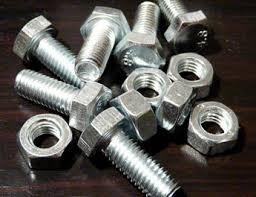How to Identify Quality 316 Stainless Steel Bolts

316 stainless steel bolts are widely used across industries for their exceptional corrosion resistance, strength, and durability. However, not all bolts labelled "316 stainless steel" meet the required quality standards. Identifying authentic, high-quality bolts ensures your applications' safety, reliability, and cost-effectiveness.
In this blog, we’ll guide you through the essential steps to identify quality 316 stainless steel bolts and make informed decisions for your projects.
What Makes 316 Stainless Steel Bolts Unique?
Before diving into quality identification, it's important to understand why 316 stainless steel bolts are so valuable:
- Corrosion Resistance: The addition of molybdenum (2-3%) enhances resistance to chlorides, making these bolts ideal for marine and chemical environments.
- Strength and Durability: They provide excellent tensile strength and can endure extreme conditions, including high temperatures and pressure.
- Versatility: Suitable for industries like marine, construction, chemical processing, and food production, where reliability is paramount.
Given their importance, using substandard bolts can lead to severe safety risks and operational inefficiencies.
1. Look for Material Certification
The first step in identifying quality 316 stainless steel bolts is to check for proper material certification.
- Reputable manufacturers provide Material Test Certificates (MTCs) to confirm the chemical composition and grade of the material.
- Verify the presence of 16-18% chromium, 10-14% nickel, and 2-3% molybdenum, which are the defining components of 316 stainless steel.
Always request documentation from the supplier to ensure you're getting authentic 316-grade bolts.
2. Inspect the Bolt’s Finish
The finish of a quality 316 stainless steel bolt is another key indicator.
- High-quality bolts have a smooth, polished surface free from visible defects, cracks, or uneven textures.
- Inferior bolts may have surface imperfections or dull finishes, which could indicate poor manufacturing practices or substandard materials.
Visual inspection is a simple yet effective way to assess the overall quality of the bolts.
3. Perform a Magnetic Test
316 stainless steel is known for its non-magnetic properties in annealed form.
- Use a magnet to check the bolt's magnetic response. A weak or negligible attraction to the magnet indicates a genuine 316 stainless steel bolt.
- Strong magnetic properties could mean that the material is of lower grade or not stainless steel.
This quick test can help you avoid counterfeit or mislabeled products.
4. Check Corrosion Resistance
A key feature of 316 stainless steel bolts is their superior corrosion resistance, especially in chloride-rich environments.
- To test this, expose the bolt to a small amount of saltwater or acidic solution for a few hours. A genuine 316 bolt will remain unaffected, while inferior bolts may show signs of rust or discolouration.
This step is particularly important for applications in marine and chemical industries.
5. Verify Manufacturer’s Standards
Reputable manufacturers adhere to international standards for producing stainless steel bolts.
- Look for compliance with certifications like ASTM (American Society for Testing and Materials) or DIN (Deutsches Institut für Normung) standards.
- Ensure the bolts meet industry-specific requirements, such as ISO 3506 for stainless steel fasteners.
Choosing a trusted manufacturer reduces the risk of receiving low-quality or non-compliant products.
6. Perform a Hardness Test
Quality 316 stainless steel bolts possess a specific hardness level, determining their strength and ability to withstand stress.
- Use a hardness testing tool to verify if the bolt meets the required standard. The hardness of 316 stainless steel is usually between 70 and 95 HRB (Rockwell B Scale).
- Inferior bolts may fail to meet these parameters, leading to premature wear or failure.
7. Assess Pricing and Supplier Reputation
Unusually low pricing can be a red flag when purchasing 316 stainless steel bolts.
- Quality bolts require high-grade raw materials and proper manufacturing processes at a certain cost.
- Work with established suppliers with a proven track record of delivering genuine products.
Suppliers with excellent reviews and certifications are more likely to provide authentic 316-grade bolts.
8. Conduct a Chemical Analysis
A chemical analysis test can verify the material's composition for critical applications.
- This test involves using a portable spectrometer or X-ray fluorescence device to detect the presence of elements like chromium, nickel, and molybdenum in the correct proportions.
- Though not always necessary, it ensures complete authenticity for mission-critical projects.
Why Quality Matters in 316 Stainless Steel Bolts
Using high-quality 316 stainless steel bolts ensures:
- Safety and reliability in demanding environments.
- Cost-efficiency by reducing maintenance and replacement needs.
- Compliance with industry standards, safeguarding your project’s integrity.
Investing in quality bolts enhances performance and ensures peace of mind in critical applications.
Conclusion
To ensure the highest standards in 316 stainless steel bolts, trust Asiad Steels, a leading name in the industry. Committed to providing premium products, Asiad Steels ensures that all bolts meet international quality standards and offer unmatched reliability for your applications.
- Art
- Causes
- Crafts
- Dance
- Drinks
- Film
- Fitness
- Food
- الألعاب
- Gardening
- Health
- الرئيسية
- Literature
- Music
- Networking
- أخرى
- Party
- Religion
- Shopping
- Sports
- Theater
- Wellness
- IT, Cloud, Software and Technology


